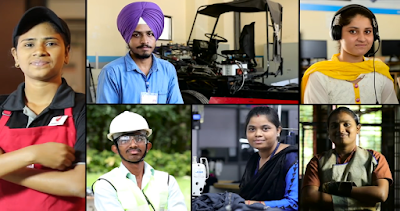 |
| Image Credit: DDU-GKY, MoRD, GoI https://youtu.be/f4aXjRaXBG0 |
“Give
the man a fish, you feed him for a day, teach him how to fish, you feed him for
a lifetime”
- Chinese Proverb
The
Monkey had been a bit occupied and hence the long break. Anyway, today we will
try to have a global outlook and its impact specific for the monkey’s
motherland, India.
The
global community is looking at a structural economic change in the current decade,
a paradigm shift from the earlier existed uni-centric, high-income country
focussed policy discourse to more broad and inclusive approach that takes along
the middle and low-income countries for a sustainable global development. The
key factor in this change has been majorly because of the vast availability of
human capital in middle and low income countries. The major lacunae that exist
in these countries is that the engagement of the working-age population in
formal sectors of employment has been paltry, thereby reducing the conversion
of their capabilities and capacities to tangible results, at a bare minimum.
This in-turn is a direct result of poor employability and lack of skilling of
the job-seeking population as the needs of the industry is often not met by the
unskilled and/or untrained job-seekers. If this trend continues, the results
could be catastrophic, including that of large scale disguised unemployment,
misuse and under-use of human capital, and at the worst- unemployment.
The
need of the hour is skilling the job-seekers, especially the under-privileged
and not-formally educated or drop-outs. The skilling process has to be an
inclusive one, that matches the capabilities and aspirations of the job-seekers
with that of the requirement of the industries. This would also require
large-scale investments for increasing the access for skill development
programs, widening the scope of these programs and ensure that even the most
under-privileged has access to them. Along with these approaches, the skill
development practices has to go hand-in-hand with increasing the employability
of the job-seeker through soft-skill developments, training in use of
technology and increasing the adaptability and retentivity of the aspirant.
The
unique aspect of skill development is that we “teach the man to fish rather than giving him a fish”, making
him more resilient to the global economic shocks and threats, which otherwise
could affect him adversely. Ensuring that a person is skilled gives him an
added advantage of availability of informed choices, better career progression
and thereby a secured future, not just to him/her, but also his/her family.
Also, the earlier male-dominated spheres of industrial work can now be extended
to the empowered womenfolk, another advantage that skill development can
provide. On similar notes, the emerging sector of service-oriented industries or the
tertiary sector, demands a high level of skilling.
India, the country which I am a native of, has the second largest population in the world, more than 1.2 billion, out of which close to 50% are below the age of 25 and 65% below the age of 35 and the average age of an Indian is close to 29 years. These figures themselves gives a shout-out on how this country is brimming with human capital. However, it is to be noted that only 2.3% of the total workforce in India has received formal training for their job-roles, a very dismal figure indeed. It is assumable that if this situation continues we are looking forward to a waste of human capital of more than 600 million people, given the fact that the Indian youth is changing its mindset from farm-based revenue to industry based jobs. The risk that the country is handling is big and this is the right time for a well-calculated investment, which would result in inclusive development of the country, better economic and social prospectus for the citizens and economic growth for the nation as such.
The
country has already set foot in the right direction and the government is
apparently serious about it, citing the formation of a Ministry, the Ministry
of Skill Development and Entrepreneurship (MSDE), engaging the private sector through the
National Skill Development Corporation on a Public-Private-Partnership mode,
and engaging its other Ministries including that of the Ministry of Rural
Development, Ministry of Home Affairs, Ministry of Housing and Urban Affairs
and the heavy-weight Skill India campaign.
But
a few years have passed since all these have happened. Are we heading
due-north? The monkey doubts. The promises and expectations have been high as
it would have been with any other campaign, but they are far from being
delivered. The possible reasons for this is the lack of quality infrastructure,
trained professionals to impart the skilling and at-times though very rare,
administrative red-tapism. We probably need a few course corrections and the
time has arrived to press the pedal, long-hard-and-steady. Along with training
them, it emphasise should also be on ensuring proper Assessment and
Certification for these trainees, adding value to their portfolio, an
incredible tool for their career progression.
The
monkey would conclude by saying that “It
is important to teach them fishing, but equally important to give the right
tool to fish”.

